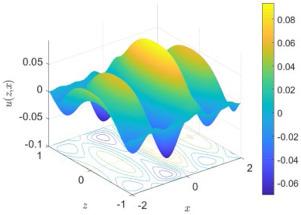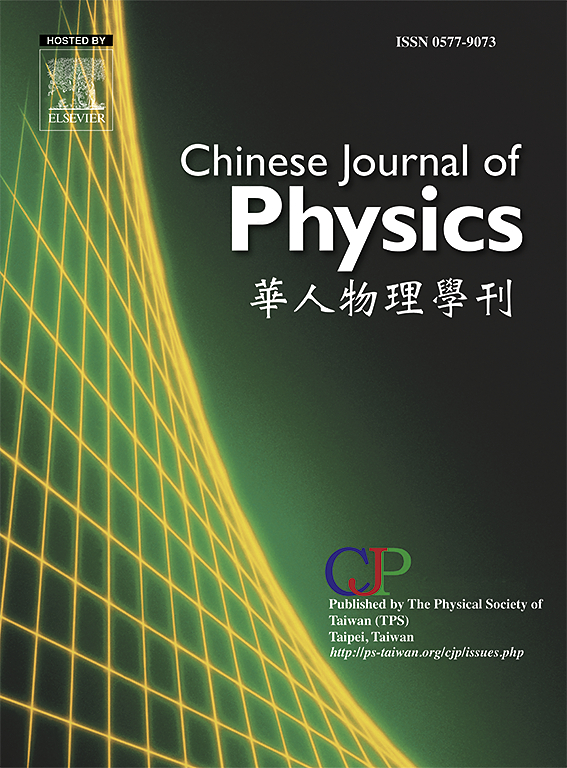电磁流体动力学和时间周期压力梯度下纳米流体在粗糙表面微通道中的热对流输运
IF 4.6
2区 物理与天体物理
Q1 PHYSICS, MULTIDISCIPLINARY
引用次数: 0
摘要
考虑电磁流体动力学(EMHD)和时间周期压力梯度的综合影响,研究了纳米流体(水-氧化铝)在粗糙表面微通道中的流动和传热特性。采用分离变量法、傅立叶余弦级数展开法,结合叠加原理和Duhamel原理,导出了速度场和温度场的解析解。在此基础上,进一步得到了努塞尔数和熵生成。通过数值模拟和理论分析,探讨了微通道内对流特性和不可逆性与各种无量纲参数的关系。关键研究结果表明,当纳米颗粒体积分数(φ)增加到0.08时,对流换热增强,努塞尔数(Nu)提高13.37%,总熵产减少17.53%。相对于α1=0.06, α1=0.12时,总熵产增加17.04%,Nu减少10.76%,这主要归因于纳米颗粒聚集和涡致不可逆性。通过哈特曼数(Ha=7 ~ 9)进行的电磁调节使中线温度降低了60%,但使Nu降低了35.4%。同时,高无因次频率(Ω=60)下的压力梯度减少了熵产振荡周期,同时通过热均质化减少了总熵产。这些结果为优化EMHD控制的微流体系统的热管理提供了重要的见解。本文章由计算机程序翻译,如有差异,请以英文原文为准。

Thermal convective transport of nanofluids through a microchannel with rough surfaces under electromagnetohydrodynamics and time-periodic pressure gradient
This study investigates the flow and heat transfer characteristics of nanofluids (water-AlO) in a microchannel with rough surfaces, considering the combined effects of electromagnetohydrodynamics (EMHD) and time-periodic pressure gradient. The analytical solutions of the velocity and temperature fields are derived using the separation of variables, Fourier cosine series expansion, combined with the superposition principle and Duhamel’s principle. Based on this, the Nusselt number and entropy generation are further obtained. Through numerical simulations and theoretical analyses, the convective characteristics and irreversibility within the microchannel are explored in relation to various dimensionless parameters. Key findings demonstrate that increasing the nanoparticle volume fraction () to 0.08 enhances convective heat transfer, elevating the Nusselt number () by 13.37% while reducing total entropy generation by 17.53%. Conversely, a larger roughness parameter () degrades thermal performance, at =0.12, total entropy generation increases by 17.04% and decreases by 10.76% relative to =0.06, attributed to nanoparticle aggregation and vortex-induced irreversibility. Electromagnetic regulation via the Hartmann number (=79) suppresses the centreline temperature by 60% but reduces by 35.4%. Meanwhile, the pressure gradient at high dimensionless frequency (=60) reduces the oscillation period of entropy generation while decreasing total entropy generation through thermal homogenization. These results offer critical insights for optimizing thermal management in microfluidic systems governed by EMHD.
求助全文
通过发布文献求助,成功后即可免费获取论文全文。
去求助
来源期刊

Chinese Journal of Physics
物理-物理:综合
CiteScore
8.50
自引率
10.00%
发文量
361
审稿时长
44 days
期刊介绍:
The Chinese Journal of Physics publishes important advances in various branches in physics, including statistical and biophysical physics, condensed matter physics, atomic/molecular physics, optics, particle physics and nuclear physics.
The editors welcome manuscripts on:
-General Physics: Statistical and Quantum Mechanics, etc.-
Gravitation and Astrophysics-
Elementary Particles and Fields-
Nuclear Physics-
Atomic, Molecular, and Optical Physics-
Quantum Information and Quantum Computation-
Fluid Dynamics, Nonlinear Dynamics, Chaos, and Complex Networks-
Plasma and Beam Physics-
Condensed Matter: Structure, etc.-
Condensed Matter: Electronic Properties, etc.-
Polymer, Soft Matter, Biological, and Interdisciplinary Physics.
CJP publishes regular research papers, feature articles and review papers.
 求助内容:
求助内容: 应助结果提醒方式:
应助结果提醒方式:


